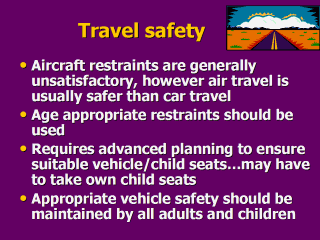| front |1 |2 |3 |4 |5 |6 |7 |8 |9 |10 |11 |12 |13 |14 |15 |16 |17 |18 |19 |20 |21 |22 |23 |24 |review |
 |
Child safety
carriers or capsules used for children should be taken with the parents or
guardians when travelling for use in motor vehicles and where necessary, and
where possible, inflight. On aircraft, very young children often fly for
free, but usually no seat is allocated in which to use a safety carrier or
capsule. A seat may become available where the flight is not full. It is
important that the child is restrained at all times when not moving about
the cabin. Moving around the cabin should be kept to a minimum and children
should not sleep on the floor or in the aisle ways. During take off, landing or during turbulence, very young children should be properly restrained. Standard airline seats belts are unsuitable for very young children as the child can slip underneath or out of them. This can result in severe injury, if the plane decelerates appreciably, given that planes travel at much higher speeds than motor vehicles. Planes can also experience unexpected vertical sheering, which can also result in injury to children or adults. Special children's restraining seatbelt, which anchors onto the parent's or guardian's seatbelt, are available and should be requested. It is important that the child is not placed inside a standard seatbelt with an adult, as the weight and the momentum of the adult during any deceleration or turbulence may crush the child (Neuman, 1996). Children are best held securely in the arms of a parent or guardian where no other option is available. During severe turbulence or a crash landing, the infants should be cocooned as the parent or guardian bends over in the crash position (Neuman, 1996). Neuman K. Child safety restraints during air travel. Traveling Healthy. December, 1996. |